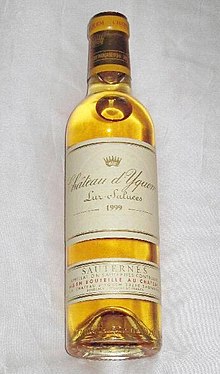Dessert wine
This article possibly contains original research. (August 2014) |

Dessert wines, sometimes called pudding wines in the United Kingdom, are sweet wines typically served with dessert.
There is no simple definition of a dessert wine. In the UK, a dessert wine is considered to be any sweet wine drunk with a meal, as opposed to the white
Methods of production

Makers of dessert wines want to produce a wine containing high levels of both sugar and alcohol. Since all winemaking creates alcohol from fermentation of sugars they are typically traded off. However, there are many ways to increase relative sugar levels in the final wine:
- grow grapes so that they naturally have sugar to spare for both sweetness and alcohol.
- add sugar, either:
- before fermentation as sugar or honey (Chaptalization)
- after fermentation as unfermented Süssreserve).
- add alcohol (typically brandy) before all the sugar is fermented (fortification or 'mutage').
- remove water to concentrate the sugar:
- In warm climates, by air drying the grapes to make raisin wine
- In frosty climates, by freezing out some of the water to make ice wine
- In damp temperate climates, by using a fungal infection, Botrytis cinerea, to desiccate the grapes with noble rot
- In warm climates, by air drying the grapes to make
Natural sweetness

In the absence of other techniques, makers of dessert wine have to produce their sugar in the vineyard. Some grape varieties, such as
Chaptalization
Honey was added to wine in Roman times, for sweetness and to increase the final strength of the wine. Today sugar is usually added in order to boost the alcohol levels of flabby, unripe wines rather than for sweetness, although a degree of chaptalization is permitted in the wines of many countries. German wines must declare whether they are 'natural' or not; in any case, chaptalization is banned from the top tiers of German wines.
Süssreserve
The 'reserve of sweetness' is a German technique in which unfermented must (grape juice) is added to the wine after fermentation. This increases the sweetness of the final wine and dilutes the alcohol somewhat—in Germany the final wine can contain no more than 15% Süssreserve by volume.[2] Süssreserve allows winemakers to fully ferment the wine without having to worry about stopping fermentation before all the sugar has gone. Since sulphites are used to stop fermentation, this technique reduces the usage of sulphites. Süssreserve is used by other makers of German-style wines, particularly in New Zealand.
Fortification

The main fortified wines drunk with dessert are sweet
The production of vins doux naturels was perfected by Arnaud de Villeneuve at the
. Regardless of the grape, fermentation is stopped with up to 10% of 95% grape spirit. The Muscats are made in a somewhat oxidised style, the Grenaches less so.Raisin wine
In ancient Carthage, a sweet wine called
Ice wine

Most wine laws require temperatures below at most −7 °C (19 °F) before the grapes for ice wine can be picked.
Noble rot wine

Some of the most famous dessert wines, such as
The fungus requires specific conditions to produce noble rot; if it is too damp, the same fungus causes destructive grey rot. Vignerons endeavour to maximise the amount of noble rot without losing the whole crop to grey rot. Typically, noble rot forms best in conditions with regular morning mist, normally from a nearby lake or the sea. The wait for noble rot to form means these wines are usually harvested late.
The first noble rot wines were likely created by accident—both the Hungarians and the Germans have similar stories of how the harvest was delayed for some reason, but the mouldy grapes were vinified anyway and then found to be delicious.[7] Given that propensity to noble rot was a factor in Hungarian vineyard demarcations some 50 years before a messenger was supposedly mugged on his way to Schloss Johannisberg in Germany and aszú inventory predates it by about 200 years, Hungary’s Tokaj is where it was first produced.[8] Germany may have later discovered the same process independently.
Noble rot is responsible for many other dessert wines, including Beerenauslese and Trockenbeerenauslese (TBA) of the German wine classification, French Monbazillac, Austrian Beerenauslese, Ausbruch and other TBA-type wines from all over the world.
Serving

A general rule is that the wine should be sweeter than the food it is served with—a perfectly ripe peach has been described as the ideal partner for many dessert wines, whereas it makes sense not to drink wine at all with many chocolate- and toffee-based dishes. Red dessert wines like Recioto della Valpolicella and fortified wines like the vin doux naturel Muscats are the best matches for such difficult-to-pair desserts.[9]
Alternatively, the wine itself can be a dessert, but bakery sweets can make a good match, particularly with a little bitterness like biscuits that are dunked in Vin Santo.[10] A development of this matching of contrasts is a rich savoury dish like the foie gras that is a traditional partner to Sauternes.[11]
White dessert wines are generally served somewhat chilled, but can be easily served too cold. Red dessert wines are served at room temperature or slightly chilled.
References
- ^ "The 7 major types of white wines". Retrieved 27 April 2019.
- ^ Süssreserve Archived 2007-03-10 at the Wayback Machine on Wine Dictionary.
- ^ Amerine, Maynard. "Wine". Encyclopedia Britannica. Retrieved 27 April 2019.
- ^ Shoemaker, Ted (6 December 2013). "German Ice Wine Rules Tightened". Wine Spectator. Retrieved 20 March 2021.
- ^ CooksInfo (4 October 2020). "Ice Wine". Cook's Info. Retrieved 20 March 2021.
- Wine Enthusiast Magazine.
- ISBN 978-0-544-33462-5.
- ISBN 0-19-866274-2.
- ^ Gorman-McAdams, Mary. "Delicious Dessert Wines for Dessert Week". The Kitchn. Retrieved 27 April 2019.
- ^ "Three of the Best Italian Dessert Wines". Italy. 12 November 2014.
- Forbes.
External links
 The dictionary definition of Dessert wine at Wiktionary
The dictionary definition of Dessert wine at Wiktionary
